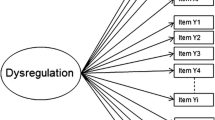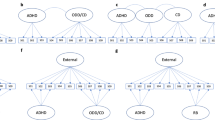Abstract
This study examined differential symptom functioning (DSF) in ADHD symptoms across Malay and Chinese children in Malaysia. Malay (N = 571) and Chinese (N = 254) parents completed the Disruptive Behavior Rating Scale, which lists the DSM-IV ADHD symptoms. DSF was examined using the multiple indicators multiple causes (MIMIC) structural equation modeling procedure. Although DSF was found for a single inattention (IA) symptom and three hyperactivity-impulsivity (HI) symptoms, all these differences had low effect sizes. Controlling for these DSF, Chinese children had higher IA and HI latent factor scores. However the effect sizes were small. Together, these findings suggest adequate support for invariance of the ADHD symptoms across these ethno-cultural groups. The implications of the findings for cross-cultural invariance of the ADHD symptoms are discussed.

Similar content being viewed by others
References
Allik, J., & McCrae, R. R. (2004). Toward a geography of personality traits: patterns of profiles across 36 cultures. Journal of Cross-Cultural Psychology, 35, 13–28.
American Psychiatric Association (1994). Diagnostic and statistical manual of mental disorders IV. Washington, DC: American Psychiatric Association.
American Psychiatric Association (2000). Diagnostic and statistical manual of mental disorders – IV text revised. Washington, DC: American Psychiatric Association.
Anastopoulos, A. D., & Shelton, T. L. (2001). Assessing attention-deficit/hyperactivity disorder. New York: Kluwer.
Ang, P. R. (2006). Effects of parenting style on personal and social variables for Asian adolescents. American Journal of Orthopsychiatry, 76, 503–511.
Barkley, R. A., & Murphy, K. R. (1998). Attention-deficit hyperactivity disorder: A clinical workbook (2nd ed.). New York: Guilford.
Barrett, P. (2007). Structural equation modeling: Adjusting model fit. Personality and Individual Differences, 42, 815–824.
Bao, K. B., & Xu, Q. M. (2006). A comparison of attachment in adolescents in mainland China and Malaysia. Chinese Journal of Clinical Psychology, 14, 172–174.
Beiser, M., Dion, R., & Gotowiec, A. (2000). The structure of attention-deficit and hyperactivity symptoms among native and non-native elementary school children. Journal of Abnormal Child Psychology, 28, 425–437.
Bentler, P. M. (1990). Comparative fit indexes in structural models. Psychological Bulletin, 107, 238–246.
Bird, H. R. (2002). The diagnostic classification, epidemiology and cross-cultural validity of ADHD. In P. Jenson, & J. Cooper (Eds.), Attention deficit hyperactivity disorder: State of the science: Best practice. Kingston, NJ: Civic Research Institute.
Bernard, H. R. (1988). Research methods in cultural anthropology. Newbury Park, CA: Sage.
Brislin, R. (1970). Back translation for cross-cultural research. Journal of Cross-Cultural Psychology, 1, 185–216.
Brown, T. A. (2006). Confirmatory factor analysis for applied research. New York: Guilford.
Burns, G. L., & Walsh, J. A. (2002). The influence of ADHD-hyperactivity/impulsivity symptoms on the development of oppositional defiant disorder symptoms in a two year longitudinal study. Journal of Abnormal Child Psychology, 30, 245–256.
Burns, G. L., Walsh, J. A., & Gomez, R. (2003). Convergent and discriminant validity of trait and source effects in ADHD-inattention and hyperactivity/impulsivity measures across a 3-month interval. Journal of Abnormal Child Psychology, 31, 529–541.
Burns, L. G., Walsh, J. A., Gomez, R., & Hafetz, N. (2006). Measurement and structural invariance of parent ratings of the ADHD and ODD symptoms across gender for American and Malaysian children. Psychological Assessment, 18, 452–457.
Butcher, J. N. (1996). Translation and adaptation of the MMPI-2 for international use. In J. N. Butcher (Ed.), International adaptations of the MMPI-2: Research and clinical applications (pp. 26–43). Minneapolis: University of Minnesota Press.
Chang, W. C., Wong, W. K., & Koh, B. K. J. (2003). Chinese values in Singapore: Traditional and modern. Asian Journal of Social Psychology, 6, 5–29.
Chao, R. K. (1994). Beyond parental control and authoritarian parenting styles: Understanding Chinese parenting through the cultural notion of training. Child Development, 65, 1111–1120.
Cheung, G. W., & Rensvold, R. B. (2000). Assessing extreme and acquiescence response sets in cross-cultural research using structural equation modeling. Journal of Cross-Cultural Psychology, 31, 187–212.
Cheung, S. F., Cheung, F. M., Howard, R., & Lim, Y. H. (2006). Personality across the ethnic divide in Singapore. Personality and Individual Differences, 41, 467–477.
Cohen, J. (1992). A power primer. Psychological Bulletin, 112, 155–159.
Department of Statistics Malaysia (2003). Population and housing census of Malaysia: Education and social characteristics of the population. Kuala Lumpur: Government of Malaysia.
Dalhan, H. M. (1991). Local values in intercultural management. Malaysian Management Review, 1, 45–50.
DuPaul, G. J., Anastopoulos, A. D., Power, T. J., Reid, R., McGoey, K. E., & Ikeda, M. J. (1998). Parent ratings of ADHD symptoms: Factor structure, normative data, and psychometric properties. Journal of Psychopathology and Behavioral Assessment, 20, 83–102.
DuPaul, G. J., Power, T. J., Anastopoulos, A. D., Reid, R., McGoey, K. E., & Ikeda, M. J. (1997). Teacher ratings of attention deficit hyperactivity disorder symptoms: Factor structure and normative data. Psychological Assessment, 9, 436–444.
Dwivedi, K. N., & Banhatti, R. G. (2005). Attention deficit/hyperactivity disorder and ethnicity. Archives of Diseases in Childhood, 90, 10–12.
Faraone, S. V., Sergeant, J., Gillberg, C., & Biederman, J. (2003). The world wide prevalence of ADHD: Is it an American condition? World Psychiatry, 2, 104–113.
Gomez, R. (2008). Invariance of parent ratings of the ADHD symptoms in Australian and Malaysian, and North European Australian and Malay Malaysia Children: A mean and covariance structures analysis approach. Journal of Attention Disorders, (in press).
Gomez, R., Burns, G. L., Walsh, J. A., & Hafetz, N. (2005). A multitrait-multisource confirmatory factor analytic approach to the construct validity of ADHD and ODD rating scales with Malaysian children. Journal of Abnormal Child Psychology, 33, 241–254.
Gomez, R., Burns, G. L., Walsh, J. A., & Moura, M. A. (2003). A multitrait-multisource confirmatory factor analytic approach to the construct validity of the ADHD rating scales. Psychological Assessment, 15, 3–16.
Gomez, R., Harvey, J., Quick, C., Scharer, I., & Harris, G. (1999). DSM-IV AD/HD: Confirmatory factor models, prevalence, and gender and age differences based on parent and teacher ratings of Australian primary school children. Journal of Child Psychology and Psychiatry, 40, 265–274.
Herrera, R. S., DelCampo, R. L., & Ames, M. H. (1993). A serial approach for translating family science instrumentations. Family Relations, 42, 357–360.
Hofstede, G. (1980). Culture’s consequences: international differences in work-related values. Beverly Hills, CA: Sage.
Hu, L. T., & Bentler, P. M. (1999). Cut-off criteria for fit indices in covariance structure analysis: conventional criteria versus alternatives. Structural Equation Modeling, 6, 1–55.
Joreskog, K. G., & Goldberger, A. S. (1975). Estimation of a model with multiple indicators and multiple causes of a single latent variable. Journal of American Statistical Association, 70, 631–639.
King, A. C. Y. (1992). Zhongguo Shehui Yu Wenhua (Chinese Society and Culture). Hong Kong: The Chinese University of Hong Kong Press.
Kirmayer, L. J. (1998). Editorial: the fate of culture in DSM-IV. Transcultural Psychiatry, 35, 339–342.
Little, T. D. (1997). Mean and covariance structures (MACS) analyses of cross-cultural data: Practical and theoretical issues. Multivariate Behavioral Research, 32, 53–76.
Livingston, R. (1999). Cultural issues in diagnosis and treatment of ADHD. Journal of American Academy of Child and Adolescent Psychiatry, 38, 1591–1594.
Lopez, S. R., & Guarnaccia, P. J. J. (2000). Cultural psychopathology. Annual Review of Psychology, 51, 571–598.
Marsh, H. W., Hau, K. T., & Wen, Z. (2004). In search of golden rules: Comment on hypothesis-testing approaches to setting cutoff values for fit indexes and dangers in overgeneralizing Hu and Bentler’s (1999) findings. Structural Equation Modeling, 11, 20–341.
Meade, A. W., & Lautenschlager, G. J. (2004). A comparison of item response theory and confirmatory factor analytic methodologies for establishing measurement equivalence/invariance. Organizational Research Methods, 7, 361–388.
Meredith, W. (1993). Measurement invariance, factor analysis and factorial invariance. Psychometrika, 58, 525–543.
Mezzich, J. E., Kleinman, A., Fabrega, H., & Parron, D. L. (Eds.) (1996). Culture and psychiatric diagnosis. Washington, DC: American Psychiatric Association.
Millsap, R. E., & Everson, H. T. (1993). Methodology review: Statistical approaches for assessing measurement bias. Applied Psychological Measurement, 17, 297–334.
Mulaik, S. (2007). There is a place for approximate fit in structural equation modeling. Personality and Individual Differences, 42, 883–895.
Muthen, L. K., & Muthen, B. O. (2006). Mplus user’s guide (4th ed.). Los Angeles, CA: Muthen & Muthen.
Pillow, D. R., Pelham Jr., W. E., Hoza, B., Molina, B. S. G., & Stutz, C. H. (1999). Confirmatory factor analyses examining attention deficit hyperactivity disorder symptoms and other childhood disruptive behaviors. Journal of Abnormal Child Psychology, 26, 293–309.
Power, T. J., Andrews, T. J., Eiraldi, R. B., Doherty, B. J., Ikeda, B., & DuPaul, G. J. (1998). Evaluating attention deficit hyperactivity disorder using multiple informants: the incremental utility of combining teacher with parent reports. Psychological Assessment, 10, 250–260.
Quah, S. R. (2004). Ethnicity and parenting styles among Singapore families. Marriage & Family Review, 35, 63–83.
Raju, N. S., Laffitte, L. J., & Byrne, B. M. (2002). Measurement equivalence: a comparison of methods based on confirmatory factor analysis and item response theory. Journal of Applied Psychology, 87, 517–529.
Reid, R. (1995). Assessment of ADHD with culturally different groups: The uses of behavioral rating scales. School Psychology Review, 24, 537–560.
Reid, R., DuPaul, G. J., Power, T. J., Anastopoulos, A. D., Rogers-Ackinson, D., Noll, M. B., et al. (1998). Assessing culturally different students for attention deficit hyperactivity disorder using behavioral rating scales. Journal of Abnormal Child Psychology, 26, 187–198.
Reise, S. P., Widaman, K. F., & Paugh, P. H. (1993). Confirmatory factor analysis and item response theory: two approaches for exploring measurement invariance. Psychological Bulletin, 114, 552–566.
Reise, S. P., Smith, L., & Furr, R. M. (2001). Invariance on the NEO PI-R neuroticism scale. Multivariate Behavioral Research, 36, 83–110.
Stansfield, C. W. (2003). Test translation and adaptation in public education in the USA. Language Testing, 20, 189–207.
Sprafkin, J., Gadow, K. D., & Nolan, E. E. (2001). The utility of the DSM-IV-Referenced Screening Instrument for attention deficit/hyperactivity disorder. Journal of Emotional and Behavioral Disorders, 9, 182–191.
Steiger, J. H. (1990). Structural model evaluation and modification. Multivariate Behavioral Research, 25, 173–180.
Steiger, J. H. (2007). Understanding the limitations of global fit assessment in structural equation modeling. Personality and Individual Differences, 42, 893–898.
Tamimi, S., & Taylor, E. (2004). ADHD is best understood as a cultural construct. British Journal of Psychiatry, 184, 8–9.
Tu, W. M. (1979). Humanity and self cultivation: essays in Confucian thought. Berkeley, CA: Asian Humanities Press.
Tu, W. M. (2003). Multiple modernities: A preliminary inquiry into the implications of East Asian modernity. In L. E. Harrison, & S. P. Huntington (Eds.), Culture matters: How value shape human process (pp. 256–267). New York: Basic Books.
Wender, E. (2004). ADHD symptoms and parent-teacher agreement. (Commentary). Journal of Developmental & Behavioral Pediatrics, 25, 48–49.
Wolraich, M. L., Lambert, E. W., & Baumgaertel, A. (2003). Teachers’ screening for attention deficit/hyperactivity disorder: Comparing multinational samples on teacher ratings of ADHD. Journal of Abnormal Child Psychology, 31, 445–455.
Wolraich, M. L., Lambert, E. W., Bickman, L., Simmons, T., Doffing, M. A., & Woricy, K. A. (2004). Assessing the impact of parent and teacher agreement on diagnosing attention-deficit hyperactivity disorder. Journal of Developmental and Behavioral Pediatrics, 25, 41–47.
Yang, K. S. (1988). Will modernization eventually eliminate cross-cultural psychological differences? In M. H. Bond (Ed.) The cross-cultural challenge to social psychology, cross-cultural research and methodology series (vol. 11). Newbury Park, CA: Sage.
Yuan, K. H. (2005). Fit indices versus test statistics. Multivariate Behavioral Research, 40, 115–148.
Author information
Authors and Affiliations
Corresponding author
Rights and permissions
About this article
Cite this article
Gomez, R., Vance, A. Parent Ratings of ADHD Symptoms: Differential Symptom Functioning Across Malaysian Malay and Chinese Children. J Abnorm Child Psychol 36, 955–967 (2008). https://doi.org/10.1007/s10802-008-9226-8
Received:
Accepted:
Published:
Issue Date:
DOI: https://doi.org/10.1007/s10802-008-9226-8




